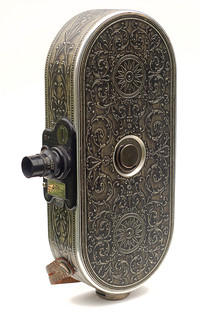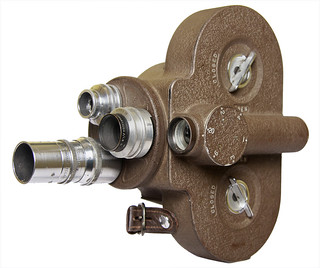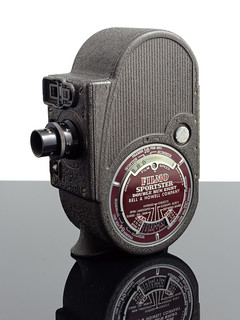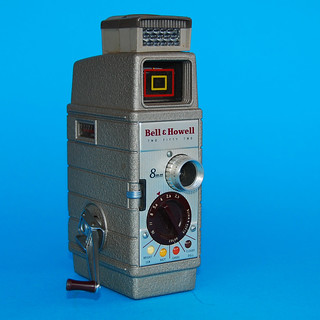Difference between revisions of "Bell & Howell"
(Couple of vague sentences about later history and ownership now; noted cheaper cameras from 1990s. Ref to current website with at least one digital camera.) |
(+ more pictures of clockwork cine cameras) |
||
| Line 1: | Line 1: | ||
| − | {{Flickr_image | + | {{stub}} |
| + | {|class="floatright plainlinks" style="margin:0px 0px 15px 15px;" | ||
| + | |{{Flickr_image | ||
| + | |image_source= http://www.flickr.com/photos/kratz/2859446077/in/pool-camerawiki/ | ||
| + | |image= http://farm4.staticflickr.com/3195/2859446077_4a2c9f971a_n.jpg | ||
| + | |image_align= | ||
| + | |image_text= Filmo 75, 16 mm clockwork cine<br/>camera from 1928, in 'Silver Birch'<br/>finish (there were also 'Ebony<br/>Black' and 'Walnut Brown') | ||
| + | |image_by= John Kratz | ||
| + | |image_rights= non-commercial | ||
| + | }} | ||
| + | |{{Flickr_image | ||
| + | |image_source= http://www.flickr.com/photos/ricksoloway/5500138535/in/pool-camerawiki/ | ||
| + | |image= http://farm6.staticflickr.com/5057/5500138535_15726244de_n.jpg | ||
| + | |image_align= | ||
| + | |image_text= <br/>Filmo 70DR clockwork cine camera<br/>with three-lens turret.<ref>[http://www.flickr.com/photos/37227626@N00/4432378206/in/pool-camerawiki/ Another, perhaps later Filmo 70DR], in the CW Flickr Pool, has a turret viewfinder too.</ref> | ||
| + | |image_by= Rick Soloway | ||
| + | |image_rights= with permission | ||
| + | }} | ||
| + | |- | ||
| + | |{{Flickr_image | ||
| + | |image_source= http://www.flickr.com/photos/nocanikons/6075938433/in/pool-camerawiki/ | ||
| + | |image= http://farm7.staticflickr.com/6188/6075938433_3757ac6b3c_n.jpg | ||
| + | |image_align= | ||
| + | |image_text= <br/>Filmo Sportster clockwork standard-<br/>eight camera, about 1946. | ||
| + | |image_by= Jim D'Intino | ||
| + | |image_rights= with permission | ||
| + | }} | ||
| + | |{{Flickr_image | ||
|image_source= http://www.flickr.com/photos/heritagefutures/4618045219/in/pool-camerawiki | |image_source= http://www.flickr.com/photos/heritagefutures/4618045219/in/pool-camerawiki | ||
| − | |image= http://farm4.static.flickr.com/3314/ | + | |image= http://farm4.static.flickr.com/3314/4618045219_c69df6a63f_n.jpg |
|image_align= right | |image_align= right | ||
| − | |image_text= B & H cine camera with [[selenium meter]] | + | |image_text= B & H 252 clockwork 8 mm cine camera<br/>with [[selenium meter]], about 1954; also<br/>made with a 3-lens turret. |
|image_by= Dirk HR Spennemann | |image_by= Dirk HR Spennemann | ||
|image_rights= with permission | |image_rights= with permission | ||
}} | }} | ||
| + | |- | ||
| + | |} | ||
| + | '''Bell and Howell''' is an American manufacturer best known in the past for motion-picture equipment. The company was started by Donald J. Bell, a projectionist, and Albert S. Howell, who worked for a maker of film projectors. Their first camera, a wooden cine camera, was made in 1910. The company's early products were very successful, and they made most of the cameras used in Hollywood for a while; however, Bell and Howell fell out, and Howell and an associate bought out Bell's share in the firm.<ref name=Gale>Gale Directory of Company Histories, 2006, Gale Group Inc.</ref> | ||
| − | + | Later, the company became one of the well-known makers of amateur cine equipment, as shown here. Bell and Howell made only a few notable still cameras. Of these, perhaps the most impressive is the [[Foton]] from 1948, a coupled-rangefinder camera with a spring motor advance allowing continuous exposures at 6 frames per second. Some of B&H's cameras came about by company acquisitions; B&H bought the '''Three Dimension Company''', which made stereoscopic cameras and equipment, and retained the TDC brand for the [[TDC Stereo Colorist|Stereo Colorist and Stereo Colorist II]] and the [[Stereo Vivid]]. | |
| − | |||
| − | Bell and Howell made only a few notable still cameras. Of these, perhaps the most impressive is the [[Foton]] from 1948, a | ||
In the 1960s, some [[Canon]] cameras (including at least the [[Canon FX|FX]], [[Canon Demi|Demi]], [[Canon Dial 35]] and some of the [[Canonet]] series) were marketed in the USA by B&H, some with and some without Canon's branding as well.<ref>McKeown shows a Dial 35 marked only for B&H; {{McKeown12}} p123.</ref> | In the 1960s, some [[Canon]] cameras (including at least the [[Canon FX|FX]], [[Canon Demi|Demi]], [[Canon Dial 35]] and some of the [[Canonet]] series) were marketed in the USA by B&H, some with and some without Canon's branding as well.<ref>McKeown shows a Dial 35 marked only for B&H; {{McKeown12}} p123.</ref> | ||
Revision as of 15:44, 30 June 2012
|
| ||||
|
|
Bell and Howell is an American manufacturer best known in the past for motion-picture equipment. The company was started by Donald J. Bell, a projectionist, and Albert S. Howell, who worked for a maker of film projectors. Their first camera, a wooden cine camera, was made in 1910. The company's early products were very successful, and they made most of the cameras used in Hollywood for a while; however, Bell and Howell fell out, and Howell and an associate bought out Bell's share in the firm.[2]
Later, the company became one of the well-known makers of amateur cine equipment, as shown here. Bell and Howell made only a few notable still cameras. Of these, perhaps the most impressive is the Foton from 1948, a coupled-rangefinder camera with a spring motor advance allowing continuous exposures at 6 frames per second. Some of B&H's cameras came about by company acquisitions; B&H bought the Three Dimension Company, which made stereoscopic cameras and equipment, and retained the TDC brand for the Stereo Colorist and Stereo Colorist II and the Stereo Vivid.
In the 1960s, some Canon cameras (including at least the FX, Demi, Canon Dial 35 and some of the Canonet series) were marketed in the USA by B&H, some with and some without Canon's branding as well.[3]
B&H stopped making professional and amateur cine cameras in the early 1970s, and concentrated on other businesses, including mechanised mail-sorting equipment[4] and microfilm. The company was subsequently involved in a large number of acquisitions and sell-offs.[2] A number of cheap cameras exist from the 1990s with the B&H brand.
The Bell and Howell brand is now (as at June 2012) owned by the holding company BHH LLC (completely separate from Bell and Howell, LLC) and is applied to a wide range of products, including some compact digital cameras.[5]
Still cameras
- Foton, 1948
- Electric Eye 127, 1958
- Autoload 340, 1967
- Autoload 341, 1970
- Autoload 342, 1970
- 35J
- BF35
Notes
- ↑ Another, perhaps later Filmo 70DR, in the CW Flickr Pool, has a turret viewfinder too.
- ↑ 2.0 2.1 Gale Directory of Company Histories, 2006, Gale Group Inc.
- ↑ McKeown shows a Dial 35 marked only for B&H; McKeown, James M. and Joan C. McKeown's Price Guide to Antique and Classic Cameras, 12th Edition, 2005-2006. USA, Centennial Photo Service, 2004. ISBN 0-931838-40-1 (hardcover). ISBN 0-931838-41-X (softcover). p123.
- ↑ Bell and Howell, LLC is still (after a relaunch) in this business; see the company website (retrieved 30 June 2012).
- ↑ B&H website (retrieved 30 June 2012).



